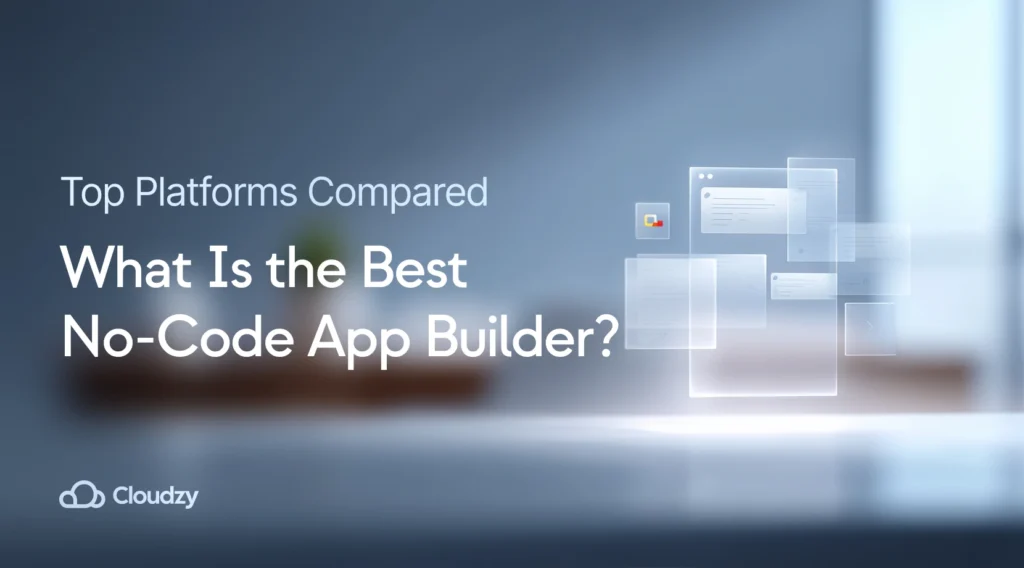You know what’s wild? Apps have become so integral to our daily lives that we barely notice them anymore. Yet behind every smooth user experience lies months of development work that most businesses simply can’t afford.
Here’s where the best no-code app builder platforms step in, fundamentally reshaping how we think about software development. Instead of wrestling with complex code at 2 AM (been there), you’re working with drag-and-drop interface tools and pre-built components that actually make sense.
The result? Feature-rich applications built in days rather than months, with zero coding expertise required.
What Is a No-Code App Builder and How Does It Work?

Picture this: remember those childhood LEGO sets where you’d follow the instructions to build something amazing? A no-code app builder works on the same principle, except you’re constructing real, functional applications.
These platforms provide visual development environments that feel surprisingly intuitive. You drag elements where you want them, connect different pieces logically, and watch your ideas come to life without touching a single line of code.
What’s fascinating about modern no-code app development platforms is how they’ve democratized access to sophisticated features. Database integration, workflow automation, and API integrations—capabilities that once required specialized development teams—are now available through intuitive visual programming interfaces.
The numbers tell the story: the best no-code app builder solutions can reduce development costs by up to 65% compared to traditional coding approaches. That’s not just a minor improvement; that’s a complete game-changer for businesses of all sizes.
Citizen developers—essentially anyone with a good idea and basic computer skills—now create mobile apps without coding using these powerful platforms. The barrier to entry has essentially disappeared.
Top 10 Best No-Code App Builder Platforms for Different Business Needs

Before diving into specific platforms, consider this: Gartner’s research suggests that 70% of new applications will leverage low-code or no-code technologies by 2025. We’re witnessing a fundamental shift in how software gets built.
| Platform | Best For | Mobile Apps | Web Apps | Key Strength |
| Bubble | Complex Logic | Progressive Web | ✅ | Visual Programming |
| Adalo | Mobile-First | Native iOS/Android | ✅ | App Store Publishing |
| Glide | Data Apps | Progressive Web | ✅ | Spreadsheet Integration |
| FlutterFlow | Performance | Native Apps | ✅ | Code Export |
| Softr | Beginners | Progressive Web | ✅ | Ease of Use |
| PowerApps | Enterprise | Wrapped Apps | ✅ | Microsoft Integration |
| Thunkable | Cross-Platform | Native Apps | ✅ | Block Programming |
| Webflow | Web Design | Progressive Web | ✅ | Design Freedom |
| Backendless | Full-Stack | Native Apps | ✅ | Backend Services |
| Mendix | Enterprise-Scale | Multi-Platform | ✅ | Enterprise Features |
1. Bubble: Most Powerful No-Code Web App Builder for Complex Applications
With nearly 5 million apps under its belt, Bubble has proven that visual programming can tackle serious business challenges. I’ve seen teams build everything from sophisticated marketplaces to complex SaaS platforms using their workflow automation engine.
What sets Bubble apart is its ability to handle intricate database relationships and advanced querying without compromising on flexibility. The learning curve exists, sure, but the payoff is substantial.
Key capabilities worth noting: • Unlimited customization potential for complex business requirements • Extensive plugin marketplace featuring thousands of specialized add-ons • Robust API integrations enabling seamless third-party connections • Responsive design system ensuring cross-device compatibility
2. Adalo: Leading No-Code Mobile App Builder for Native Applications
Here’s something impressive: Adalo has facilitated the creation of over 1 million apps, serving more than 2 million registered users. These aren’t just prototype numbers—they represent real, functioning applications.
This no-code application builder excels at native app publishing directly to both the Apple App Store and the Google Play Store. The simultaneous web app development capability means you’re essentially building once and deploying everywhere.
Adalo’s comprehensive mobile app development suite includes AI app builder features with ChatGPT integration, automated database creation through Magic Start, extensive API integrations via their Component Marketplace, and sophisticated deep linking capabilities that rival traditional development approaches.
3. Glide: Best No-Code Web Application Builder for Data-Driven Apps
Glide does something particularly clever—it transforms existing spreadsheets into polished mobile app builder solutions almost instantly. If your business already runs on Google Sheets or Airtable, this becomes incredibly powerful.
This no-code web application builder specializes in creating visually appealing applications from your existing data sources. The AI app builder functionality can generate functional apps from simple natural language descriptions, which feels almost magical when you first experience it.
Built-in user authentication, real-time data synchronization, and an extensive template library make Glide particularly well-suited for internal business tools and customer-facing portals.
4. FlutterFlow: Top No-Code App Builder for Native Performance
FlutterFlow takes a different approach by leveraging Google’s Flutter framework to create truly compiled applications. This codeless app builder generates clean, exportable Flutter code—meaning you’re not locked into their ecosystem permanently.
The platform’s Firebase integration provides enterprise-grade backend services, while custom code integration options offer unlimited extensibility. With over 200 customizable UI components, FlutterFlow successfully bridges the gap between no-code accessibility and professional development quality.
What’s particularly valuable is the offline capability support, making it ideal for field applications where internet connectivity might be unreliable.
5. Softr: Best No-Code Software Builder for Complete Beginners
Sometimes simplicity is exactly what you need. This no-code software builder focuses relentlessly on accessibility, making app development approachable for complete newcomers to the space.
Softr excels at creating client portals, membership sites, and internal business tools directly from existing Airtable or Google Sheets data. The drag-and-drop interface requires zero technical knowledge while consistently delivering professional-looking results.
The platform includes everything necessary for quick deployment: built-in SEO optimization, membership management systems, and payment processing that actually works reliably.
6. Microsoft PowerApps: Enterprise-Grade No-Code Application Builder
In enterprise environments, PowerApps dominates through seamless Microsoft 365 integration and access to over 1,000 pre-built connectors. If your organization already lives in the Microsoft ecosystem, Microsoft PowerApps, as a candidate for the best app builder without coding, becomes an obvious choice.
This enterprise-focused top no-code app builder utilizes the Common Data Model for data consistency, integrates with Power Automate for workflow automation, and includes AI Builder for intelligent feature implementation. Azure Active Directory integration ensures compliance security, HIPAA, and SOC 2 standards are met without additional configuration.
The Wrap feature enables native iOS and Android distribution, though this requires some additional setup compared to dedicated mobile platforms.
7. Thunkable: Cross-Platform No-Code Mobile App Builder
Thunkable pioneered the block-based visual programming approach for mobile app builder creation, using an MIT-inspired interface that makes complex logic accessible through puzzle-like programming blocks.
This platform supports simultaneous iOS and Android development from a single project, which is particularly valuable for resource-constrained teams. This no-code mobile app builder enables true cross-platform development with real-time device testing, an extensive component library, and full native hardware access.
The block-based approach might seem simplistic initially, but it’s surprisingly powerful for implementing complex application logic.
8. Webflow: Professional No-Code Web App Builder for Design Excellence
Webflow combines visual web design capabilities with serious development functionality. This no-code web app builder enables pixel-perfect websites and web applications without traditional coding limitations.
The design tools rival professional design software while generating clean, semantic code behind the scenes. Webflow provides comprehensive web solutions through integrated CMS functionality, e-commerce capabilities, and managed hosting services.
For teams where visual design is paramount, Webflow’s learning resources and active community support make the transition from traditional development surprisingly smooth.
9. Backendless: Full-Stack Codeless App Builder Platform
Backendless offers comprehensive backend-as-a-service capabilities combined with visual frontend development tools. This platform handles both database integration and user interface creation through its codeless development approach.
The platform delivers real-time database management, sophisticated user management systems, file storage capabilities, and serverless computing infrastructure. Multiple deployment options include cloud hosting and on-premises installation with API-first architecture.
For teams needing complete control over their application stack, Backendless provides unusual flexibility within the no-code space.
10. Mendix: Enterprise-Scale No-Code App Development Platform
Mendix leads enterprise low-code development through advanced governance features and collaboration tools designed for large-scale digital transformation initiatives requiring complex integrations.
Multi-experience development capabilities span web, mobile, and wearable devices through a unified development environment. Mendix particularly excels at mission-critical business applications through advanced offline capabilities, microservices architecture support, and enterprise-grade security features.
The investment required is significant, but for organizations where application downtime translates to substantial revenue loss, Mendix provides the reliability needed.
Essential Features to Evaluate in No-Code App Development Platforms

After working with various platforms, certain features consistently separate genuinely useful tools from mere marketing demonstrations.
Database Integration and Real-Time Data Management
Modern no-code app development platforms must provide robust database integration capabilities for dynamic applications. Look beyond basic CRUD operations toward visual database builders, sophisticated relationship management tools, and seamless external data source connections.
Progressive web apps require reliable data synchronization across devices and sessions. Native mobile apps need offline data capabilities that actually work in real-world scenarios. Enterprise scalability depends heavily on how platforms handle growing datasets and increasing concurrent user loads without performance degradation.
Workflow Automation and Business Logic Implementation
The most valuable platforms offer automation tools that genuinely rival traditional development capabilities. Visual workflow automation builders should enable complex business logic implementation without requiring programming knowledge, though some technical thinking remains beneficial.
API integrations become crucial for extending functionality by connecting applications to external services. Effective workflow automation often determines whether no code mobile app builder projects can scale beyond simple prototypes into production-ready solutions.
Security and Compliance Standards for Business Applications
Enterprise applications demand robust security measures protecting sensitive business data. Leading platforms provide HIPAA compliance, SOC 2 certification, and enterprise-grade data encryption specifically for regulated industries.
The most reliable top no-code app builder platforms implement compliance security, HIPAA SOC 2 protocols automatically, removing the burden of manual security configuration from development teams.
How to Choose the Right No-Code Platform for Your Business

Platform selection often feels overwhelming, especially considering the Bureau of Labor Statistics projects the US developer shortage will exceed 1.2 million positions by 2026. This gap makes choosing the right no-code solution increasingly critical.
Startup and MVP Development Requirements
Early-stage companies benefit from platforms like Adalo or Softr that emphasize rapid prototyping with minimal learning curves. Prioritize platforms offering generous free plans and transparent pricing that scales predictably with business growth.
Native app publishing capabilities become essential as user bases expand. Market timing often determines startup success more than feature completeness, making speed to deployment crucial for teams looking to create a mobile app without coding.
Enterprise Application Development Needs
Larger organizations typically require platforms like Microsoft PowerApps or Mendix that provide enterprise-grade features with advanced governance and security frameworks. These platforms excel at handling complex integrations and supporting large-scale deployments.
Enterprise solutions must demonstrate compliance with security, HIPAA SOC 2 standards from day one. Integration with existing business systems isn’t negotiable—it’s a fundamental requirement when evaluating the best app builder without coding options.
Design-Focused Project Requirements
Teams prioritizing visual excellence often gravitate toward Webflow and Glide, which offer extensive template libraries and sophisticated customization options without compromising functionality.
The ability to create a mobile app without coding shouldn’t require sacrificing visual quality. User experience remains paramount regardless of development approach when working with any app builder without coding.
Hosting Solutions for No-Code Applications

Once you’ve built applications using any codeless app builder, reliable hosting infrastructure becomes essential. While many platforms include hosting, some scenarios require external solutions for optimal performance.
Applications expecting significant growth benefit from VPS server solutions, providing dedicated resources and predictable scalability. Enterprise applications often perform better with Cloud VPS infrastructure optimized for demanding workloads.
E-commerce applications built with no-code platforms frequently require specialized hosting environments optimized for online transactions, such as Magento VPS solutions offering comprehensive e-commerce functionality and security.
Future Trends in No-Code App Development

The no-code movement continues revolutionizing software development throughout 2025 through artificial intelligence integration and continuously improving platform capabilities. Organizations increasingly recognize substantial return on investment, with Forrester research demonstrating that leading platforms can deliver 506% ROI over three-year periods.
AI Integration and Intelligent Automation
AI app builder features are rapidly becoming standard across leading platforms. Intelligent suggestions, automated testing capabilities, and natural language programming interfaces significantly streamline development processes.
These advances make an app builder without coding increasingly accessible to non-technical users, while the learning curve continues decreasing. We’re approaching a point where describing desired functionality might be sufficient for basic application generation.
Market Growth and Citizen Developer Adoption
Citizen developers now create approximately 80% of technology products, according to recent Gartner predictions. The global no-code market continues to expand as organizations recognize efficiency benefits and cost savings.
Market maturation brings improved platform stability, enhanced security features, and better integration capabilities across the ecosystem.
Platform Evolution and Advanced Capabilities
Cross-platform development capabilities improve continuously, with better native app performance and seamless deployment across multiple platforms from a single development project.
Advanced platforms increasingly offer source code export options, hybrid development models, and professional deployment capabilities. These features successfully bridge the gap between no-code simplicity and traditional development flexibility.
Conclusion

Selecting the best no-code app builder in 2025 ultimately depends on your specific requirements, technical constraints, and target audience expectations. Bubble leads for complex web applications requiring sophisticated logic, while Adalo excels for mobile-first projects demanding native app publishing capabilities.
For beginners, Softr provides the most accessible learning curve while delivering professional results. Enterprise teams benefit significantly from PowerApps’ Microsoft integration, while FlutterFlow offers superior performance for demanding applications requiring native functionality.
The no-code revolution has democratized professional app creation across industries and skill levels. Choose platforms that align with current needs while providing room for future growth and scalability as your requirements evolve.
